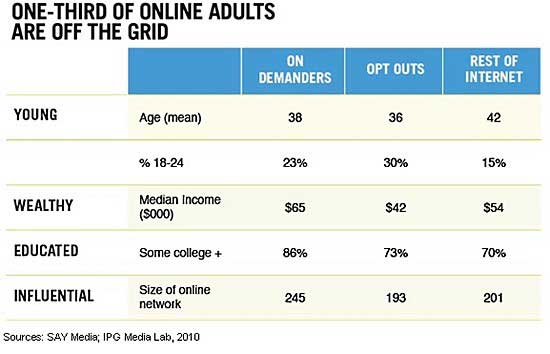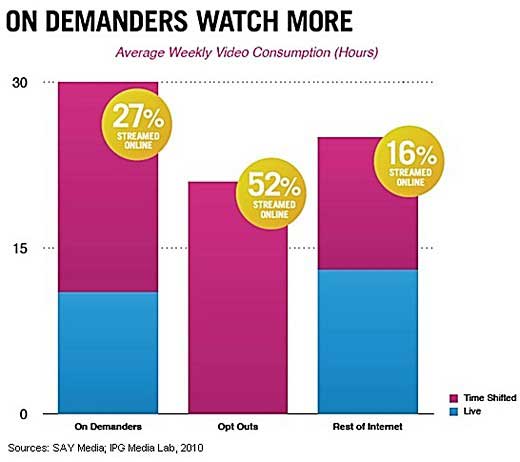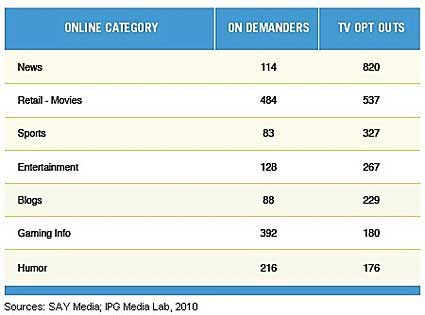Next-generation media consumers, or "Off the Gridders," are young, educated, and affluent, and they spend less time viewing live TV but more time viewing online and time-shifted premium video content, according to a study by SAY Media. Such tech-savvy consumers are also difficult to reach via traditional broadcast media and other broadly targeted ad campaigns.
Off-the-Grid consumers constitute one-third of the online adults in the US, nearly 56 million people, according to the study. Off the Gridders are composed of two segments: "On Demanders" (20% of online adults) and "TV Opt Outs" (13% of online adults).
On Demanders consume more video content weekly than Internet users on average, primarily via time- and device-shifting, but they are the least receptive to TV, online, and mobile ads. For example, 52% of On Demanders say online ads are too long, compared with 42% of all Internet users. Similarly, On Demanders are also more likely to agree there are too many ads for each TV video content segment.
Key characteristics of On Demanders include the following:
- On Demanders own an average of 5.4 devices for watching video, including their TV and personal computer.
- 47% subscribe to Netflix, compared with 24% of all Internet users.
- 40% own video-enabled mobile devices such as smartphones or iPads.
On Demanders are younger than Internet users on average (age 38 vs. age 42), more educated, and affluent—and tend to be influential in their own personal networks. For example, On Demanders who use social media have 245 social media connections on average (Facebook, MySpace, Foursquare, etc.), compared with 201 for all Internet users who use social media.

TV Opt Outs are even younger on average (age 36) and educated: 73% have some college education.
Below, other findings from the study titled Off the Grid: Marketing to the Next Generation Media Consumer, by SAY Media and IPG Media Lab.
On Demanders Watch More Video Content
On Demanders watch 30 hours of video content weekly, compared with 21 hours for TV Opt Outs and 25 hours for all Internet users. Roughly one-half of TV Opt Outs' video content (52%) is streamed online, as is 27% of On Demanders' content.

The evening hours (8:00 pm to 11:00 pm) are still primetime viewing hours for all media consumers. Even three out of four TV Opt Outs watch video content during that time, though not live TV. Roughly one-half of On Demanders—as well as all Internet users—are watching live TV during that time slot.
Looking for great digital marketing data? MarketingProfs reviewed hundreds of research sources to create our most recent Digital Marketing Factbook (May 2010), a 296-page compilation of data and 254 charts, covering email marketing, social media, search engine marketing, e-commerce, and mobile marketing. Also check out The State of Social Media Marketing, a 240-page original research report from MarketingProfs.
Opt Outs Most Receptive to Ads
TV Opt Outs spend on average of 57 hours monthly streaming online content—roughly two hours a day—compared with On Demanders (42 hours per month) and all Internet users (33 hours).
TV Opt Outs spend nearly eight times more minutes viewing online news content than On Demanders (i.e., they index at 820 minutes vs. 114 minutes), and three times more minutes watching sports content (327 vs. 83) than all Internet users. TV Opt Outs also index higher for engaging with blogs.

Meanwhile, On Demanders spend more time with online entertainment categories, such as gaming and humor.
Interestingly, TV Opt Outs are more receptive to online and mobile advertising. Opt Outs understand the implicit trade-off for receiving their favorite shows and programming for free, online or via streaming video, according to SAY media.
About the data: Findings are based on qualitative and quantitative research, including a passive behavioral analysis via comScore's opt-in panel, of 1,159 Internet users, consisting of 232 Opt Outs and 305 On Demanders, as well as face-to-face interviews with eight Off-the-Grid households in Chicago and San Francisco; the studies were conducted by TRU in August 2010.



